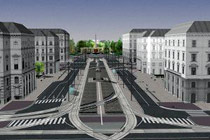Panel Discussion
Schwarzenbergplatz. The Past and Future of a Public Space
Lecture and Panel Discussion in German in Cooperation with the Wien Museum

Schwarzenbergplatz. The Past and Future of a Public Space
© Alfredo Arribas
Site Dynamics. On the history of the development of Schwarzenbergplatz
Lecture by Bernadette Reinhold, art historian
Created by the building of the Vienna Ringstrasse, the topographical lie of Schwarzenbergplatz, its being sandwiched in-between roads, represented a design challenge from the outset putting the redesign proposed by Alfredo Arribas once again at the focus of interest. The dynamics of the location’s development have been markedly influenced by socio-political connotations which, alongside the still effective presence of industry and the remnants of grand aristocratic worlds, had close links with events of national importance and military character dating from the time of the monarchy to the erection of the Red Army memorial. And also beyond ‘major historical significance’ here, there are narratives of relevance to urban life. Meaning that Arribas’ proposal, and above all its realisation, is worthy of more comprehensive discussion than merely as a building project.
Followed by a discussion
Moderation: Wolfgang Kos, Director of the Wien Museum
Bernadette Reinhold, art historian
Christian Kühn, president of the Architekturstiftung Österreich
Siegfried Mattl, Insititut für Zeitgeschichte, University of Vienna
Boris Prodrecca, architect in Vienna, chaired the jury for the appraisal
Erich Petuelli, Municipality Vienna, Architecture and Urban Design
A cooperation with the Wien Museum.
What happened so far ….
There has hardly been another adaptation of a historic site by the City of Vienna to have aroused so much controversy as the plans for Schwarzenbergplatz. Following months of rebuilding the partially recognisable completed parts led to hasty prejudgements that failed to take the fact into consideration that the new complete image of the sensitive structural interventions were not entirely to be seen.
Following an appraisal by experts in 1998 the project Vienna Limelight by the Spanish architect Alfredo Arribas was selected as the winning proposal, aiming to make a design intervention worthy of this urban space in terms of the urban structure and the historic significance of the original substance. The design now being realised, and originally presented to the public by the Az W in 2002, looks different – as so often happens. What are the influences and factors responsible here?
Before the official opening at the start of June 2004, in cooperation with the Wien Museum, the Architekturzentrum Wien cordially invites you to take a critical look at the past and present of the site. The aim of the event is to revive constructive dialogue in the field of tension between the conservation of historic buildings and the initiation of necessary architectural interventions. A presentation of the background history is to broaden the depth of understanding of the two conflicting positions. The reasons for the adaptation of the architect’s original concept are also to be outlined.
